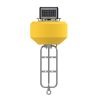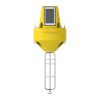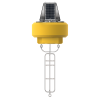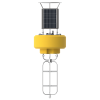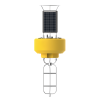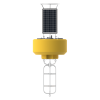SeaView Systems SVS-603HR Wave Sensor
Features
- Plug-and-play interface with the full line of NexSens XB-Series & CB-Series data buoys
- Sophisticated onboard electronics provide near-real-time wave statistics
- On-board data logger capable of logging as much as twenty years of wave data
- Expedited repair and warranty service
- Lifetime technical support
- More
The SeaView Systems SVS-603HR represents a new generation in accuracy and completeness for wave sensing electronics whose features include:
- Low power consumption; fits the smallest power budget
- Small environmental footprint; sold packaged or as bare PCB
- Sensors account for 3-D motion, rotation and compass heading in all dimensions to cover nine degrees of freedom
- Onboard electronics provide near-real-time wave statistics
- Variable sample set size (256, 512, 1024, 2048 or 4096)
- On-board temperature compensation
- On-board data logger capable of logging as much as twenty years of wave data, depending on desired outputs
- Easy configuration to match exact sensing rate and output requirements
- Readily interfaced with transmitter using NMEA or other configurable data output
- Sampling rates from 1 to 8Hz (user configurable)
The SVS-603HR can be used to replace existing sensors, to upgrade existing buoys, or to add wave sensing capabilities to even the most compact buoys. Among the wave data that are available as outputs from the sensor are:
- Significant wave height in meters (Hs)
- Wave period in seconds
- Wave direction in degrees from north
- North, east and up displacement time series
- First-5 Fourier wave coefficients
- Maximum wave height (Hmax)
- Wave period at Hmax
- Wave energy
- Spectrum (raw or processed)
- Heading in degrees
- Custom outputs as required
In The News
Wave Sensors Integration with NexSens Buoys: A Cutting-Edge Solution for Wave Measurement
Real-time wave data supports accurate weather prediction, safe and efficient maritime operations, and provides valuable safety and operating condition information for recreation and commercial fishing. Understanding wave dynamics also helps with the design of protective coastal structures like seawalls, breakwaters, and jetties. It also supports better prediction of their impact on sediment transport and coastal geomorphology. Wave data is a key factor in qualifying and designing offshore wind farms and harnessing kinetic energy for electrical generation. It helps with the understanding of ocean-atmosphere interactions and contributes to studies of sea-level rise and climate change impacts.
Read MoreFrom Paddles to Phytoplankton: Studying Vermont’s Wildest Lakes
For six months of the year, Rachel Cray, a third-year PhD student at the Vermont Limnology Laboratory at the University of Vermont, lives between a microscope and her laptop, running data. For the other six months, she is hiking and canoeing four of Vermont’s lakes, collecting bi-weekly water samples. Cray studies algal phenology across four lakes in Vermont, US, that have low anthropogenic stress—or in other words, are very remote. Funded by the National Science Foundation Career Award to Dr. Mindy Morales, the lakes Cray researches part of the Vermont Sentinel Lakes Program, which studies 13 lakes in the area and, in turn, feeds into the Regional Monitoring Network, which operates in the Northeast and Midwest US.
Read MoreReimagining Water Filtration: How Monitoring and Science Enhance FloWater Filtration Systems
Over 50% of Americans think their tap water is unsafe , according to the Environmental Working Group (EWG). Other recent surveys have found that number to be as high as 70% of persons surveyed. Whether due to increased public awareness of water quality issues or confusion about how municipal water sources are regulated, there is a clear distrust of tap water in the United States. According to industry expert Rich Razgaitis, CEO and co-founder of the water purification company FloWater, this issue creates a damaging cycle. Razgaitis explained that the health and environmental problems associated with contaminated water aren’t the only issues. As people become increasingly aware that some tap water is unsafe, they resort to bottled water.
Read More









